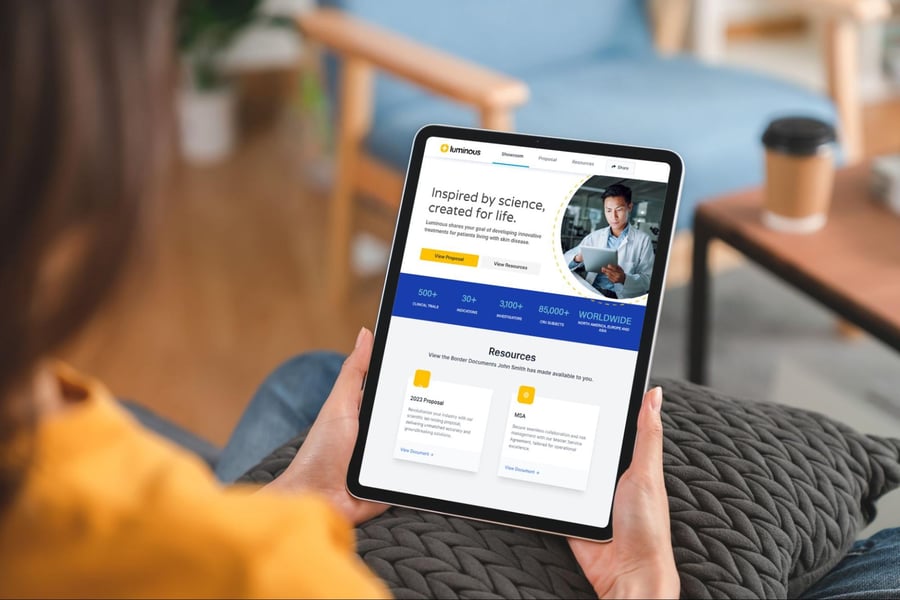Digital Sales Room: Why No Modern Sales Team Is Complete Without One
When you think of a sales room (or showroom), the first thing that likely comes to mind is a brightly lit car dealership with shiny, top-of-the-line vehicles. You can see your reflection on the hood, the seats are in perfect condition, and you’re intoxicated by that “new car smell.” Assuming your budget and credit score are in good shape, you'll be ready to drive off the lot in one of these bad boys today.
Now imagine being able to capture that same energy with a digital sales room.
Increasingly, B2B sales teams are adopting digital sales rooms to create a better online buying experience that wins more deals. Keep reading to learn more about digital sales rooms and how they’re being used to delight buyers and close sales.
Talewind automates the creation of digital sales rooms—we call them showrooms—to save your sales team time. See it in action with a free demo.
What is a digital sales room?
A digital sales room—sometimes referred to as a digital showroom or virtual showroom—is a centralized, branded online location that allows buyers to become intimately familiar with your product or service and convinces them to engage with your business.
“The digital sales room is a key part of the pre-closing phase of the sales process. Essentially, it replaces the typical proposal, where you’re trying to answer all the questions a prospect may have,” explains Lance Cummins, president of the growth content company Nectafy.
This is because the sales room gives prospects immediate, convenient access to the resources you’ve made available instead of having to sift through a cluttered, disjointed collection of emails—some with attachments, some that answer a random question they had, etc.—from multiple members of your team.
“You know how it goes—prospects may get an email from you, a PDF attachment, a video from Loom, and so on,” says Cummins. “While this has been the standard for some time, the evolution of technology always shows us there’s a smarter way to do things.”
Cummins also says digital sales rooms are flexible “because they not only enable customers to go on their own sales journey in navigating the resources you’ve made available but also give you the tools to synchronously walk customers through the sales room and answer questions—all in one place.”
Digital Sales Rooms In Different Industries
As our opening example noted, digital sales rooms are quite prevalent in the automotive industry. Consider online car dealerships like Carvana that have 3D imagery of the interior and exterior of vehicles, which makes it feel like you're viewing them in person. You can even configure the vehicle using different options and see how those options change the vehicle’s look.
Ecommerce has a similar concept. For example, Amazon product listings sometimes provide the means to not only configure a product but also interact and solidly visualize it with augmented reality.
“Essentially any industry where its products are typically evaluated in person before purchasing can be suitably translated into digital representations in a virtual showroom,” Cummins explains.

Digital Sales Rooms: Product Vs. Service
While most people can only imagine a digital sales room being used to sell products—items you can typically see and touch, such as the industry examples above—you can also use these sales rooms to sell services.
So you don’t have to be a car manufacturer or online retailer to make use of digital sales rooms. You can be a digital marketer, managed services provider, or even an accountant.
“With physical products, it’s much like what we would picture with an auto showroom except online,” says Cummins. “But services are intangible—you can’t rotate or zoom in on a service. So digital sales rooms become something a bit different in this context.”
How do you use digital sales rooms to sell your service?
According to Cummins, you need to create a place where prospects feel like they get a strong sense of what your services can do for them and their business. You may think, We already do this on our website. But your website isn’t tailored to a specific prospect; nor does it address how your service applies specifically to their business.
“When prospects enter a space you’ve tailored just for them, they pay more attention and are more receptive to what you’re sharing. That alone is a key differentiator of a digital sales room,” Cummins explains. “Every salesperson knows that attention and receptivity are two hallmark traits you want in a buyer.”
“When prospects enter a space you’ve tailored just for them, they pay more attention and are more receptive to what you’re sharing.”
For example, if you’re a digital marketer, you may choose to include:
- Scope of work
- Work samples
- Videos of you walking through your marketing process
- Team profiles
- Website traffic graphs and other visuals for different KPIs
- Client case studies
“For each of these items, you’d only be including content most relevant to the prospect’s business and the questions they’ve asked,” says Cummins. “So if your client is, say, a heavy machinery manufacturer, you’d include case studies of other manufacturers and work samples of related content.”
How Digital Sales Rooms Help Scale Sales Pitches
“If you’re selling high-value services in the B2B space, your sales process likely has a lot of engagement with the prospect team,” says Cummins. “There are multiple touch points, a sufficient amount of complexity, and several people to convince that your business is the right choice.”
You also have the chaos of using multiple solutions—recall the earlier example of prospects receiving answers and informational content from multiple sources.
The digital sales room brings all these elements together in one place so all the prospect has to do is click one link to access all relevant resources and get answers to all the questions they need to make their decision.
“On your end, the sales room saves your team a ton of time. You only need to create materials once and then customize it for each client,” says Cummins. The right digital sales room can help speed this customization process up and increase accuracy through automation. “The less time you’re spending building proposals and supporting assets, the more time you have to find new prospects.”
Digital Sales Rooms Provide A Window Into Your Sales Process
As with any modern business solution, analytics are a key part of measuring the return on your investment. What parts of the sales room are attracting the most interest? Which assets are seeing the most engagement? Is the sales room even being used at all?
Robust digital sales rooms can give you a detailed audit of who is looking at what and for how long, how many times an asset has been accessed and at what times, at what point a video has been paused, and so on.
“These analytics are useful for gaining insight on not only the sales room itself but also your overall sales process,” says Cummins.
For example, say you’ve put a lot of effort into a customized video, but analytics reveal that the prospect doesn’t show interest in watching it. Now you can brainstorm the problem and explore the cause. “Maybe you did a poor job placing the video on the site or didn’t properly inform the prospect on what and how much information the video shared,” says Cummins.
As for the sales process, Cummins notes that if your sales room is consistently a ghost town, the prospect “may not be psychologically committed enough to proceed to that next step. You may need to build momentum before introducing the sales room and get a clear indication from the prospect that they will continue to engage in the process.”
Would your sales team benefit from a digital sales room?
While any company could make use of a digital sales room, the scalability of this type of solution makes it most fitting for selling to larger companies. The more decision-makers you have on the buying committee, the more complicated the sale and the more you can benefit from having a centralized experience for everyone involved.
“Every salesperson dealing with large prospects has had to conduct multiple meetings with different members of the buying committee, and resend materials to multiple emails,” Cummins explains. “Not to mention the internal forwards that occur where the salesperson isn’t able to provide context or explanation, which can lead to misinterpretation and a lost sale. A digital sales room mitigates these headaches.”
The same benefit is true for your own sales team. A centralized location helps keep your sales assets aligned and organized, and limits the upkeep and mental strain of using multiple solutions to create and send those assets.
Enter Talewind, an automated proposal generation solution for organizations looking to not only centralize their sales presentation efforts, but also significantly reduce the time required to push out proposals to time-sensitive prospects. With Talewind, you can quickly create stunning digital sales rooms—which we call showrooms—to instill that “wow” factor in the eyes of your buyers.
Schedule your free demo of Talewind today to see this “wow” factor in action.



